Quick Look
Grade Level: 4 (3-5)
Time Required: 45 minutes
Expendable Cost/Group: US $1.00
Group Size: 1
Activity Dependency:
Subject Areas: Science and Technology
NGSS Performance Expectations:

| 3-5-ETS1-3 |
Summary
Students investigate how sound travels through string and air. First, they analyze the sound waves with a paper cup attached to a string. Then, they combine the string and cup with a partner to model a string telephone. Finally, they are given a design challenge to redesign the string telephone for distance. They think about their model as it compares a modern telephone and the impact the invention of the telephone has had on society.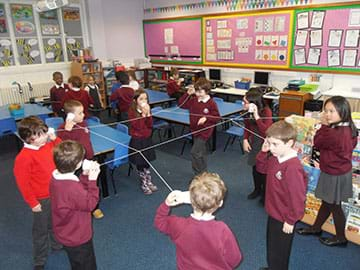
Engineering Connection
Engineers systematically analyze materials and processes in order to create things for the benefit of humanity and our world. Communications engineers are particularly focused on sound and creating technology to transmit sound long distances with little loss in clarity.
Learning Objectives
After this activity, students should be able to:
- Describe how sound travels through different media.
- Model and analyze a string telephone.
- Recognize that technology has helped people communicate over long distances.
Educational Standards
Each TeachEngineering lesson or activity is correlated to one or more K-12 science,
technology, engineering or math (STEM) educational standards.
All 100,000+ K-12 STEM standards covered in TeachEngineering are collected, maintained and packaged by the Achievement Standards Network (ASN),
a project of D2L (www.achievementstandards.org).
In the ASN, standards are hierarchically structured: first by source; e.g., by state; within source by type; e.g., science or mathematics;
within type by subtype, then by grade, etc.
Each TeachEngineering lesson or activity is correlated to one or more K-12 science, technology, engineering or math (STEM) educational standards.
All 100,000+ K-12 STEM standards covered in TeachEngineering are collected, maintained and packaged by the Achievement Standards Network (ASN), a project of D2L (www.achievementstandards.org).
In the ASN, standards are hierarchically structured: first by source; e.g., by state; within source by type; e.g., science or mathematics; within type by subtype, then by grade, etc.
NGSS: Next Generation Science Standards - Science
| NGSS Performance Expectation | ||
|---|---|---|
|
3-5-ETS1-3. Plan and carry out fair tests in which variables are controlled and failure points are considered to identify aspects of a model or prototype that can be improved. (Grades 3 - 5) Do you agree with this alignment? |
||
| Click to view other curriculum aligned to this Performance Expectation | ||
| This activity focuses on the following Three Dimensional Learning aspects of NGSS: | ||
| Science & Engineering Practices | Disciplinary Core Ideas | Crosscutting Concepts |
| Plan and conduct an investigation collaboratively to produce data to serve as the basis for evidence, using fair tests in which variables are controlled and the number of trials considered. Alignment agreement: | Tests are often designed to identify failure points or difficulties, which suggest the elements of the design that need to be improved. Alignment agreement: Different solutions need to be tested in order to determine which of them best solves the problem, given the criteria and the constraints.Alignment agreement: | |
International Technology and Engineering Educators Association - Technology
-
Communication technology is the transfer of messages among people and/or machines over distances through the use of technology.
(Grades
3 -
5)
More Details
Do you agree with this alignment?
-
Models are used to communicate and test design ideas and processes.
(Grades
3 -
5)
More Details
Do you agree with this alignment?
Materials List
Each student needs:
- 1 paper cup
- piece of string (about 2 feet, or 30 cm)
- 1 small nail
- String Telephones Worksheet
For the entire class to share:
- extra paper cups
- several 6-8 foot (1.8 - 2.3 m) pieces of string
- (optional) nylon or different types of string
- blank white paper
- pencils
Worksheets and Attachments
Visit [www.teachengineering.org/activities/view/cub_sound_lesson02_activity1] to print or download.Pre-Req Knowledge
Students should be familiar with sound being described as a wave. This activity works well accompanying a science unit on sound or waves.
Introduction/Motivation
Have you ever noticed that you can hear sounds through solids? Everyone put your ear to you desk and scratch the surface with your fingernail. Now sit up and again scratch the desk surface. Is there a difference? (Have a few students comment, one at a time. Make sure they recognize that the sounds are louder with their ears to the desks.)
If you can hear a sound through your desk, does that mean your desk is moving? Take one minute to discuss with the people around you what is happening. (The answer is yes, tiny parts of the desk are moving with the sound wave. Refer to the slinky example in the associated lesson if more explanation is required.)
So when sound travels through a solid, it travels the same way as it does through air: in a sound wave. The sound wave actually moves the tiny particles, or molecules, that make up the solid. We now know from experience that these sound waves sound louder when we hear them through solids. If you wanted to say something to your friend on the other side of the playground, would your friend be better able to hear you through the air or through a solid? (Poll students.)
One reason engineers learn about sound waves is to design things that help people talk to each other over long distances, like the telephone, cell phone, or the internet. Engineers are helping bring the world closer together by developing technologies that enable long-distance communication. Today we are going to learn more about how sound travels using a paper cup and string. We are going to model a simple string guitar, analyze how sound moves through our model, and think about how the model relates to a telephone. Then we are going to combine our models with a partner's to make string telephones for two-way communication.
Procedure
Before the Activity
- Gather materials.
- Make copies of the String Telephones Worksheet.
With the Students
Explain the procedures to the students before passing out the materials.
Part 1: Model of a String Guitar
- Use a nail to make a small hole in the bottom of a paper cup (see Figure 1).
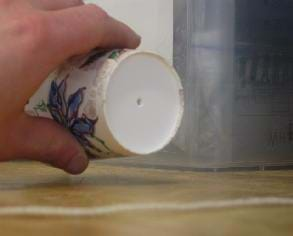
- Pull string through the cup and tie a knot (see Figure 2).
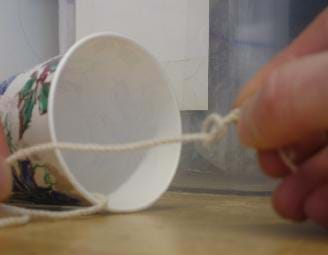
- Hold string straight out from cup with two fingers of one hand, pressing your fingernail to hold it extra tight (see Figure 3).
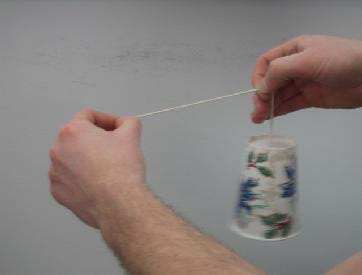
- Gently draw your other finger along the string, making a sound.
- Ask the students the following questions and discuss as a class: A. What do you hear? (Answer: The sound comes from your moving finger and it is quiet.) B. What do you feel? (Answer: The motionless fingers holding the string feel vibrations.)
- Now hold the cup in one hand and draw your finger along the string as before, as shown in Figure 4. Ask students the following questions, and discuss as a class.
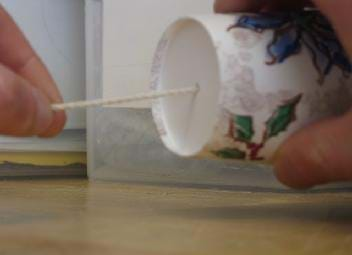
- Where is the sound? (Answer: It is in the cup, and it is louder.) Note: This happens because the cup vibrated enough to create a sound wave in the air, which we could then hear. The hand does not vibrate enough to produce a sound.
- What happened to the vibration you felt in your hand? (Answer: It left when I transferred my hand to the cup.)
- Where do you think the vibration went? Or did it just disappear? (Answer: It went into the cup instead of my hand. It did not just disappear.)
- So why was there sound from the cup? (Answer: The vibration, or sound wave, from my finger traveled along the string and into the cup. The cup transferred the vibration into the air, which we could then hear.)
Part 2: Model of a String Telephone
- Find a partner and tie the two loose ends of your strings together.
- Stand away from each other so the string is taut.
- Speak to one another through the cups.
- Experiment with your string telephone by gently pulling the string taut and then letting it fall loose.
- Ask the students and discuss as a class:
- How does the telephone work? (Example answer: When you speak into the cup, the back of the cup vibrates; the vibration extends into the string, like a push on a slinky; the sound waves, or vibrations, move through the string.)
- Which works better: taut or loose? Why? (Answer: Taut; when the string is loose it is softer than when it is taut. Soft materials tend to absorb more sound that solid ones; when more sound is being absorbed, your friend on the other end of the line cannot hear as well.)
- What happens when the vibrations (sound waves) reach the other end of the cup? (Answer: It is the reverse of what happened on the other side: the waves in the string vibrate the cup; the vibrations from the cup disturb the air, like a pebble being thrown into still water; the vibrations in the air, otherwise known as sound waves, travel toward our ears.)
Part 3: Analyze and Improve the Model
- Have students analyze their string telephones using the following questions:
- How well did the string telephone work? (Answers will vary.)
- Where do the sound waves travel in the string telephone? (Answer: The sound waves travel from the first person's mouth, into the first cup, down the string, vibrate the second cup, and into the ears of the second person.)
- What could you do to make the string telephone work better? (Answers will vary.)
- The String Telephone Company has hired you as engineers. They want you to design a new string telephone for people who are six feet or more apart from each other. They think that this would be useful for siblings in different rooms or friends who live next door. You have 10 minutes to brainstorm with your partners and draw your new designs. You may use new materials to test your design. (Have students draw their new designs on the worksheets or blank paper.)
- Have students answer the worksheet questions.
Vocabulary/Definitions
acoustics: The study of sound; the characteristics of sound in an environment.
Alexander Graham Bell: Inventor of the telephone.
communications engineering: The branch of engineering having to do with developing and maintaining technology used for communication, such as telephones.
medium: A substance that sound travels through.
Assessment
Pre-Activity Assessment
Poll: During the introduction, ask students the following question. Tally the votes.
- Would your friend on the other side of the playground be better able to hear you through a solid or through the air?
Activity Embedded Assessment
Prediction: Before Part 2 of the activity, have students predict whether they think the string telephone will work better with a loose or taut string. Record predictions on the board.
Question/Answer: Ask students the questions found in the Procedures section. Review their answers to gauge their mastery of the subject.
Post-Activity Assessment
Question/Answer: Ask students the following questions, allowing several to answer:
- How is a string telephone similar to a modern telephone that you would use in your house or school? (Answer: Both telephones have a receiver on each end and a path that the sound travels in the middle. However, modern telephones rely on the conversion of the sound waves into an electrical signal.)
- What are some times when communicating long distances is important? Can you think of a time when it was important for you to talk to someone far away? (Answers will vary.)
- How have telephones improved how people communicate? (Answers will vary.)
Iterate the Designs: Have students think about modifying their final string telephone designs even more. What would they do to further improve their designs? Would they change the materials for the cups or string? What might they use? Have students think about other features on telephones. What special features would they want to include on their string telephones? Give students time to draw or describe their new design ideas.
Troubleshooting Tips
The string pulls out of the hole in the paper cups if students pull too hard. If this happens attach the string to a small paper clip to anchor it in the cup. This does not affect the sound performance.
Activity Extensions
Have students compare the loudness of sound with the distance of the cups. Give them a longer length of string with which to test, and have them decrease the length of string by half each time to see if distance affects the sound. They should notice a difference, since sound waves lose strength with distance (as learned in the associated lesson). Explain to students that engineers have helped sound travel great distances by designing devices that convert the sound waves into electricity and back.
Have students try other modern telephone features on their string telephones. For example, does it work if they introduce "three-way calling" with three cups?
Subscribe
Get the inside scoop on all things TeachEngineering such as new site features, curriculum updates, video releases, and more by signing up for our newsletter!More Curriculum Like This

Students are introduced to communications engineers as people who enable long-range communication. In a demonstration, students discuss the tendency of sound to diminish with distance and model this phenomenon using a slinky.

Students are introduced to sound energy concepts and how engineers use sound energy. Through hands-on activities and demonstrations, students examine how we know sound exists by listening to and seeing sound waves

Students learn about the types of seismic waves produced by earthquakes and how they move through the Earth. Students learn how engineers build shake tables that simulate the ground motions of the Earth caused by seismic waves in order to test the seismic performance of buildings.
Copyright
© 2008 by Regents of the University of Colorado.Contributors
Michael Bendewald; Malinda Schaefer Zarske; Janet YowellSupporting Program
Integrated Teaching and Learning Program, College of Engineering, University of Colorado BoulderAcknowledgements
The contents of this digital library curriculum were developed under a grant from the Fund for the Improvement of Postsecondary Education (FIPSE), U.S. Department of Education, and National Science Foundation GK-12 grant no 0338326. However, these contents do not necessarily represent the policies of the Department of Education or National Science Foundation, and you should not assume endorsement by the federal government.
Last modified: August 11, 2023









User Comments & Tips